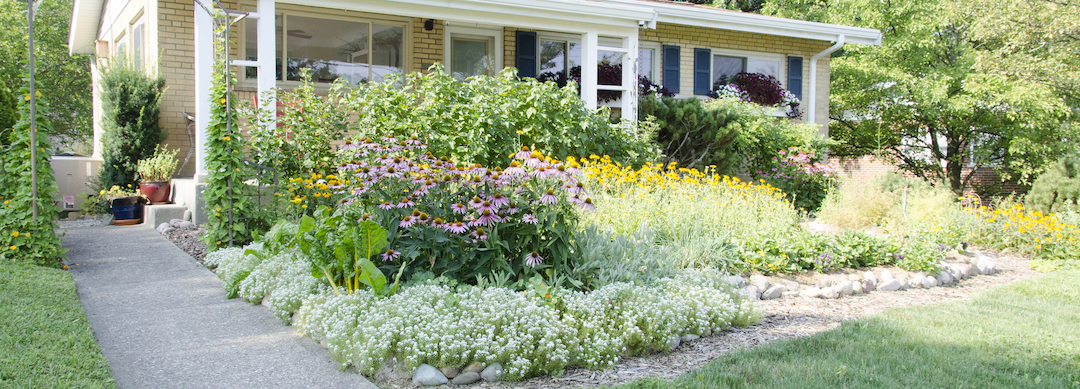Introduction
Permaculture is more than just a gardening technique—it’s a holistic approach to designing sustainable, self-sufficient systems that work in harmony with nature. The term “permaculture” combines “permanent” and “agriculture,” reflecting its goal of creating agricultural ecosystems that are resilient, regenerative, and sustainable. This approach integrates ecological principles to design productive environments that mimic natural ecosystems. For many, transitioning to permaculture gardening represents a commitment to sustainable living and a desire to reduce environmental impact.
A permaculture garden is not only about growing food; it’s about creating a self-sustaining ecosystem that supports both plants and animals while minimizing waste and resource use. By adopting permaculture principles, gardeners can cultivate a thriving garden that supports biodiversity, conserves resources, and promotes a balanced, healthy environment. This guide will walk you through the essential steps to create your own permaculture garden, from initial design to advanced practices, helping you achieve a productive and eco-friendly garden.
1. Getting Started with Permaculture Gardening
Understanding Permaculture Principles
Permaculture is grounded in three core ethics: Earth Care, People Care, and Fair Share. These ethics guide the design and implementation of permaculture systems, ensuring that they are sustainable and equitable. Earth Care focuses on nurturing and maintaining the health of the natural environment, while People Care emphasizes the well-being of individuals and communities. Fair Share, or redistribution of surplus, involves sharing resources and knowledge to ensure that everyone’s needs are met.
Design principles in permaculture include observing and interacting with natural systems, catching and storing energy, and producing no waste. By integrating these principles into garden planning, you can create systems that are not only productive but also environmentally friendly. Understanding these principles is crucial for setting the foundation of your permaculture garden, as they will influence every aspect of your garden’s design and management.
Choosing the Right Location
Selecting the right location for your permaculture garden is essential for its success. Start by assessing the site’s sunlight exposure, soil quality, and water availability. Permaculture gardens benefit from ample sunlight, which supports healthy plant growth. Examine how sunlight moves across your garden throughout the day and choose a spot that receives adequate light for your plants’ needs.
Soil health is another critical factor. Conduct a soil test to determine its pH, nutrient levels, and texture. Healthy soil is rich in organic matter and supports a diverse microbial ecosystem. If your soil requires improvement, consider adding compost or other organic amendments. Water availability is also crucial; ensure that your garden has access to a reliable water source and consider incorporating rainwater harvesting systems or irrigation techniques to manage water efficiently.
Basic Tools and Materials Needed
To start your permaculture garden, you’ll need a few basic tools and materials. Essential tools include a spade, fork, trowel, and pruning shears. These tools will help you prepare the soil, plant seeds, and maintain your garden. Additionally, consider investing in a good-quality compost bin or tumbler to recycle organic waste and create nutrient-rich compost for your garden.
Materials such as mulch, which helps retain soil moisture and suppress weeds, are also important. Organic mulches, like straw or wood chips, are excellent choices for a permaculture garden. Finally, having a rain gauge to monitor water levels and a soil thermometer to track soil temperature can help you manage garden conditions effectively.
2. Designing Your Permaculture Garden
Creating a Permaculture Garden Plan
A well-thought-out garden plan is crucial for the success of your permaculture garden. Begin by sketching a layout of your garden space, considering factors like sunlight, wind direction, and topography. Divide your garden into zones based on how frequently you will interact with each area. For example, place high-maintenance plants and vegetable beds closer to your home for easy access, while less frequently visited areas can be used for perennials or natural habitats.
Companion planting and creating plant guilds are integral to permaculture design. Companion planting involves growing plants together that benefit each other, such as planting nitrogen-fixing legumes alongside heavy feeders like tomatoes. Guilds are groupings of plants that support one another in various ways, such as providing shade, attracting beneficial insects, or repelling pests. Designing your garden with these principles in mind will enhance productivity and create a balanced ecosystem.
Incorporating Water Management Techniques
Effective water management is essential in permaculture gardening. Techniques such as swales and rain gardens help manage and conserve water by capturing and directing rainwater to where it is needed most. Swales are shallow, contoured ditches that collect and slow down water flow, allowing it to infiltrate the soil and recharge groundwater. Rain gardens, on the other hand, are depressions planted with water-loving plants that absorb and filter rainwater runoff.
Drip irrigation systems and water harvesting methods, such as rain barrels or cisterns, can further enhance water efficiency in your garden. Drip irrigation delivers water directly to the plant roots, reducing evaporation and runoff. Harvesting rainwater not only conserves water but also provides a free and sustainable water source for your garden.
Building Soil Health and Fertility
Healthy soil is the foundation of a productive permaculture garden. Building soil fertility involves incorporating organic matter such as compost, manure, and green manure crops. Composting kitchen scraps, yard waste, and other organic materials creates nutrient-rich compost that improves soil structure and fertility. Vermiculture, or worm composting, is another effective method for producing high-quality compost.
Mulching is another essential practice for maintaining soil health. Organic mulches, like straw or wood chips, help retain soil moisture, suppress weeds, and improve soil fertility as they decompose. Additionally, incorporating practices like crop rotation and cover cropping can enhance soil health and prevent nutrient depletion, ensuring a thriving garden ecosystem.
3. Planting and Cultivation
Selecting Permaculture Plants
Choosing the right plants for your permaculture garden is crucial for its success. Opt for a mix of perennials, which provide long-term yields and require less replanting, and annuals, which offer seasonal variety. Native plants are also an excellent choice as they are adapted to your local climate and soil conditions, requiring less water and maintenance.
Edible species, such as herbs, vegetables, and fruits, should be selected based on your dietary preferences and local growing conditions. Incorporating a variety of plants that serve multiple purposes—such as providing food, habitat, or pest control—can enhance the overall productivity and sustainability of your garden.
Planting Techniques and Layout
The way you plant and arrange your garden can significantly impact its productivity. Consider planting in raised beds, which improve soil drainage and provide a controlled growing environment. Rows and traditional garden beds are also effective, but ensure they are designed to accommodate the growth habits of your chosen plants.
Using greenhouses or cold frames can extend the growing season and protect sensitive plants from harsh weather conditions. These structures provide a controlled environment that supports seed starting, early planting, and extended harvests. Incorporate these techniques based on your specific climate and gardening goals.
Maintaining Your Garden
Ongoing maintenance is key to a thriving permaculture garden. Implement integrated pest management strategies that include attracting beneficial insects, such as ladybugs and lacewings, which prey on pests. Companion planting can also help deter harmful insects and diseases.
Seasonal care involves monitoring plant health, adjusting watering schedules, and performing necessary pruning. Regularly check for signs of disease or nutrient deficiencies and address them promptly. By staying proactive and attentive, you can ensure your garden remains healthy and productive throughout the year.
4. Advanced Permaculture Practices
Integrating Animals into Your Garden
Incorporating animals into your permaculture garden can offer numerous benefits. Chickens, for example, can help control pests, provide nutrient-rich manure, and even help with weeding. Bees are essential for pollination, boosting fruit and vegetable yields. However, managing animal impact is crucial to prevent overgrazing and soil erosion. Providing adequate shelter, food, and water, as well as rotating animals through different areas, can help balance their presence in the garden.
Other animals, such as ducks and goats, can also be integrated into permaculture systems, each offering unique advantages. For example, ducks can help manage slugs and pests, while goats can clear brush and contribute to soil fertility. Understanding the needs and benefits of each animal will help you create a harmonious and productive garden ecosystem.
Energy Efficiency and Resource Use
Energy efficiency is an important aspect of permaculture gardening. Incorporating renewable energy solutions, such as solar panels or wind turbines, can reduce your garden’s reliance on non-renewable resources. Additionally, implementing energy-saving practices, such as using passive solar design principles or optimizing garden layouts for natural light and ventilation, can further enhance sustainability.
Waste reduction and recycling are also key components of permaculture. Implement composting systems to recycle organic waste and reduce landfill contributions. Utilize materials like cardboard, wood chips, or straw as mulch or garden bedding to minimize waste and improve soil health.
Community Involvement and Education
Permaculture is not just about individual gardening efforts; it’s also about building community and sharing knowledge. Participating in local permaculture networks, attending workshops, and engaging with gardening communities can provide valuable insights and support. Sharing your own experiences, successes, and challenges with others can contribute to the collective knowledge and advancement of permaculture practices.
Creating community gardens or educational programs can help spread the principles of permaculture and encourage more people to adopt sustainable gardening practices. By fostering a culture of collaboration and learning, you can contribute to a more resilient and sustainable future.
Conclusion
Creating a thriving permaculture garden involves understanding and applying fundamental principles of sustainability, design, and maintenance. By following the steps outlined in this guide, you can develop a productive and eco-friendly garden that supports biodiversity, conserves resources, and enhances your overall quality of life. Permaculture gardening is not only a way to grow food but also a commitment to living in harmony with nature. Embrace the journey, and enjoy the rewards of a garden that reflects your values and dedication to sustainability.





